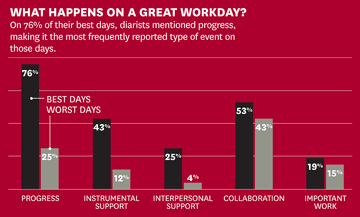From the previous generations there is no evidence that building more autonomy and purpose into our work environments may lead to happier and more productive people. Luckily times are changing and leaders have to get out of the way for their organizations to survive in the knowledge economy.
Behavioral science shows that we want to be self-directive. But the truth is that we are climbing out of the industrial revolution and simply don’t know how to redesign our workplaces for more autonomy. It is still tempting to believe that the best way to motivate people is with external rewards like money.
According to Daniel Pink that is a mistake. In his latest book Drive: The Surprising Truth About What Motivates Us, he builds on more than 40 years of research on motivation to prove that there are flaws in this thinking. But it is only now – when we can no longer deny the end of the industrial revolution and failing of ‘if-then motivation technology’ – that these insights are starting to make sense.
Carrots and Sticks
To understand why the carrot-and-stick logic is failing more and more we need to have a look at what drives people. Human beings are stimulated by a mix of drives: biological drives (we do things because we are hungry, thirsty, horny, etc.); a reward and punishment drive (the external reward to which we do respond very well) and a contribution drive (doing things because they are interesting and because they give us a feeling of belonging).
Over the past decades, ‘work’ as we know it since the industrial revolution has changed. In our knowledge economy, work is no longer repetitive, straightforward, well defined and rules-based. Yet, this is what all of the past generations in the world of work have been doing for a living and for a very long time.
Today’s work is increasingly non-routine. It requires a greater degree of creativity in order to solve the more complex challenges. The bad news is that carrot-and-stick motivators – which are very good when you need to follow a repetitive set of instructions – are no longer effective in this new context. According to Pink, this requires a different ‘technology for motivating people to do it’.
Pink also found that external rewards sometimes demotivate people. He calls them ‘if-then’ motivators. This means that they are very good at focusing our minds and directing our attention in a tight way. This is great to achieve specific and well defined goals. But when performing creative and conceptual tasks they are less effective. As Pink puts it: ‘this defies the laws of behavioral physics.’
Internal or External Rewards?
To cut this one short: you have to pay people enough. Frederick Herzberg’s Two Factor Theory (1959) is a ‘classic’ that is still proves to be valuable in this context. According to this theory, people are influenced by two factors. First, motivation factors, which help increase satisfaction but have little effect on dissatisfaction. Second, hygiene factors which, if absent or inadequate, cause dissatisfaction, but their presence has little effect on long-term satisfaction.
The external reward of money is a hygiene factor; if you are not paying people enough, there will be no motivation. You have to pay people enough to get the issue of money off the table. If people are paid enough they can focus on the work. That is when you can switch to what Frederick Herzberg called the ‘motivators’: the factors which help increase performance.
But then, which rewards leads to enduring performance? To Dan Pink, the answer is pretty clear:
1. Autonomy: need to direct our own lives;
2. Mastery: the desire to learn and create new things;
3. Purpose: being in service of something that is larger than oneself
Note: these are all internal rewards and they call for managers and leader to replace control with trust; in other words: to get out of the way. The Atlassian example in the video above is an example of radical autonomy that reduces if-then motivation and infuses autonomy in the workplace.
Autonomy allows people to make progress and animates what people are doing with a greater sense of purpose. Instead of engineering elaborate incentive schemes, managers should recognize progress and shine a light on progress. In their book Switch: How to Change Things When Change Is Hard, Chip and Dan Heath refer to this as finding the ‘bright spots’ and using them actively for shaping the path.
It’s Not About Rewards, It’s About Progress!
And there is more. The biggest surprise in this debate comes from the research findings that suggest that rewarding is not the issue at all. What really motivates people is the sense of making progress!
In a recent article of Harvard Business Review, Teresa Amabile and Steven Kramer present the astonishing results of a multiyear study tracking the day-to-day activities, emotions, and motivation levels of hundreds of knowledge workers.
A close analysis of nearly 12,000 diary entries, together with the writers’ daily ratings of their motivation and emotions, shows that making progress in one’s work—even incremental progress—is more frequently associated with positive emotions and high motivation than any other workday event.
The authors conclude that managers have powerful influence over events that facilitate or undermine progress. They can provide meaningful goals, resources, and encouragement, and they can protect their people from irrelevant demands. Again, the great catchphrases of Jeff Jarvis – the Google evangelist – resonate here: First, be a platform; then, get out of the way!






Pingback: Luc’s Thoughts on Organizational Change » Gamers Will Save Our Economy (Part 2)()